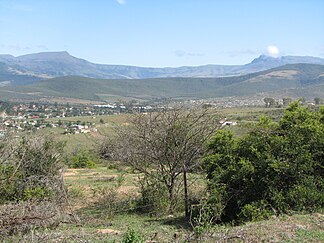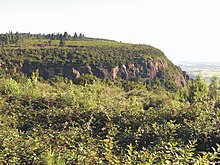Amathole Mountains
| Amathole Mountains | ||
|---|---|---|
|
View of the chain of Amathole mountains near Keiskammahoek |
||
| Highest peak | Gaika's Kop ( 1963 m ) | |
| location | Eastern Cape Province ( South Africa ) | |
|
|
||
| Coordinates | 32 ° 35 ′ S , 27 ° 12 ′ E | |
The Amathole Mountains ( English Amatole Mountains , after isiXhosa also Amathole Mountains ) are the eastern part of a steeply sloping altitude level in the South African province of Eastern Cape . The administrative district of the same name is named after them. The Amathole Mountains are one of the most forest and water rich regions in this province.
Location of the Amathole Mountains
The mountains extend in the Amathole district in a west-east direction in a slightly curved shape. In a northerly direction the mountain range runs out into an undulating highland that borders the Katberg area of the Winter Mountains to the west and the Windvoëlberg near Cathcart to the north . Its southern foreland consists of hills and several valleys that descend into the plain between the towns of Fort Beaufort and King William's Town .
The chain of Amathole Mountains runs from the Juanasberg area with Tyhume Peak (1480 m above sea level) in the west to the heights flowing out of the Toise River in the east.
To the west is the Elandsberg massif , which forms the transition to the chain of winter mountains. In the east the mountain range drops into the valley of the Toise River, which flows over the Kubusi to the Great Kei River .
Landscape and division
The Amathole Mountains are characterized by some striking peaks. In the west these are the Gaika's Kop (1963 m above sea level) and the Menziesberg (1644 m). Then follow the three peaks of Hogsback (up to 1936 m) and further east and near the Dontsa pass Mount Thomas (1617 m) and Kubusi (1662 m). Between the two mountains, at right angles to the main ridge of the Amathole Mountains, the small Isidenge Mountains with the highest peaks Mount Kempt (1420 m) and Mount Charybdis (1289 m) connect. The easternmost foothill of the main chain is called Kologha Mountain (also Xolora ), which has its highest peak with Dohne Peak (1454 m).
In their center they enclose the Keiskamma Basin with the foothills of the Isidenge Mountains.
Origin and geology
The Amathole Mountains are the result of volcanic activity in the southern hemisphere during the Lower Jurassic period, when magma penetrated the sedimentary layers of the Karoo main basin and lifted parts of them. The sandstone slab was penetrated and split in many places by dykes and sills (storage tunnels) made of dolerite . The bulges of the mountains consist in most cases of dolerite intrusions, which have dolerite rubble and eroded, mostly sloping sandstone layers on their flanks . The southern edge of the mountain slopes steeply and often forms a clearly defined edge . This relief leads to steep rock walls in numerous places and is the cause of several waterfalls.
Climate and ecosystem
The climate is temperate in the upper mountain areas, but subtropical in the lower areas. In the winter period there can be considerable snowfall in the mountain regions over 1000 meters. However, the snow cover is only available for a short time. In the warmer periods, precipitation falls here, the amount of which can reach 1300 mm per year. The hilly and plains offshore to the south have relatively little rainfall and are significantly warmer.
Parts of the original forest landscape still exist on the slopes of the Amathole Mountains. They are placed under protection in their sensitive areas and are only accessible in a few places due to the relief of the terrain and their biodiversity. Parts of the mountain range are being examined by the Landmark Foundation because they are to be protected as a biosphere reserve .
The individual forest areas on the main range of the mountains are west to east: Auckland Forest, Hogsback State Forest, Malan Forest, Cata Forest, Mount Thomas Forest, Kubusi State Forest, and Fort Cunynghame Forest. On the foothills to the south are: Wolf River Main Forest, Lenye Forest, Piri Main Forest, Cwencwe Forest and Isidenge State Forest.
The Black ( Acacia mearnsii ), Green ( Acacia decurrens Fabaceae ) and Silver Wattle ( Acacia dealbata ) plants, which invasively spread in some forest areas, are often observed in nearby forest areas. For this purpose, the Amatola Wattle Survey program of the Department of Water Affairs and Forestry (DWAF) and the Forestry Enterprise Development Office was launched to investigate and map the harmful spread of these plants.
The water balance of the mountains results from the precipitation and the good storage capacity of the Karoo sandstone layers. The watercourses of the northern slope drain the area over the adjoining highlands into the system of the Great Kei River. The southern slope has innumerable small watercourses. The largest rivers here are the Tyhume River and Keiskamma River .
Soil erosion is an increasing problem in some parts of the mountain range and its foreland. It not only leads to the loss of valuable rural areas, but also threatens the functionality of some water abstraction systems. The clayey-sandy fine-grain sediments settle in dams and thus reduce the water storage capacity.
colonization
The region is mainly structured in a rural way. There are only a few larger settlements with a small town character on the slopes and feet of the mountains. These are the cities of Stutterheim and Keiskammahoek .
The southern foothills with the side valleys is a traditional and still preferred settlement area of the Xhosa and is therefore covered with numerous scattered village settlements. Many roads have been paved here since 1994 and the drinking water infrastructure has been improved.
A few farms exist between the Xhosa settlements, which in most cases represent individual groups of houses. The town of Hogsback is a specialty, which owes its existence to a rest stop on an old military road, but which was significantly influenced in its development by wealthy merchants from East London and Port Elizabeth. In this context, it forms a “park-like” settlement in the pleasant climate at an altitude of over 1000 meters with its garden properties, some of which are worth seeing.
traffic
The upper central mountain regions can only be reached on unpaved country roads and paths. Some parts are closed to public car traffic for nature conservation reasons. At the eastern end, the well-developed N6 national road crosses the mountains. To do this, it has to cross the expiring mountain range in a gentle ascent to reach the highlands stretching north and to lead the traffic on to Cathcart.
An electrified railway line runs almost parallel to this national road on the eastern slope of the mountain, which it crosses with a tunnel at the summit of its slope. It connects East London with Queenstown . Originally a narrow-gauge railway operated here , which only ran as far as Cathcart and had a different, much more differentiated route. This line is no longer in operation today, the tracks have been dismantled and are still clearly visible as a visitor attraction in the former Old Thomas River station not far from the Amathole Mountains.
The western part of the Amathole Mountains is accessed through the Hogsback pass road. It replaced the mountain crossing over Michel's Pass , which required a long drive through the Kat River valley via Seymour.
In the mountains of the main chain there is a relatively well-developed network of trails for backpackers ( Amatole Hiking Trail ).
economy
Few economic activities are possible in the Amathole Mountains area. The main source of income is forestry, some plantations, tourism, regional self-sufficiency structures and public administration.

After 1994, the administration of the Eastern Cape Province promoted reforestation measures and the expansion of the drinking water supply systems in a special way . There is an intensive timber industry in the region around Stutterheim. The native Xhosa population lives from these companies or works as service personnel in the tourism industry, provided they have a job. Part of it commutes to the nearby urban centers of King William's Town, Keiskammahoek, Bhisho and Alice or to the industrial area of Dimbaza .
To a small extent, the grasslands are used as a source of raw materials for traditional basket-making and, in particular, broom- making work . The grass species Cymbopogon validus , called Irwashu by the Xhosa, is at the center of the collecting activity . These handicraft activities are accompanied by a regional project and are primarily carried out in the area of the municipality of Mxhalanga . Mxhalanga is at the southeast end of the small Isidenge mountain range. The finished products from these activities are offered for sale in Alice, Cathcart, East London, King William's Town, Queenstown and Stutterheim.
One particular employer is the University of Fort Hare , which offers technical and scientific jobs.
The white indigenous population earn their income on farms, in the factories in the surrounding small towns or as academic staff at the University of Fort Hare.
The nature reserves and sensitive ecosystems in the mountain regions are gaining in economic importance. It is advertised on the basis of gentle ecotourism and themed tours with animal and plant observation are offered.
Attractions
The sights of the Amathole Mountains and their foreland include:
- Mountain Trail Amatole Hiking Trail
- Keiskammahoek
- fortified ranger settlement from 1878 near Stutterheim
- Hogsback waterfalls and garden lots
- Forest stands in the region
- Road at the Dontsa Pass
- Chief Sandile's grave
- Amathole Museum in King William's Town with an extensive collection
- Ntaba KaNdoda memorial near Dimbaza
literature
- 3226 King William's Town, 1: 250,000, topo-cadastral, Chief Director of Surveys and Mapping Privat Bag Mowbray, Mowbray 1985
- Cristine Philipp: South Africa . REISE Know-How Verlag, Markgröningen 2006, ISBN 3-89662-348-6
- Mike Raath, Dorothy Pitman, Jenny Bennie: Museums of the Eastern Cape . SAMA Eastern Cape, Port Elizabeth 1996, ISBN 0-620-19916-4
Web links
- Biodiversity in the vicinity of Stutterheim ( Memento from December 8, 2011 in the Internet Archive ) (English)
- Sandile's grave ( Memento from December 8, 2011 in the Internet Archive )
- Water extraction in the Buffalo City area ( Memento from October 16, 2013 in the Internet Archive ) (English; archive version)
- Water management in the Eastern Cape (English, PDF file; 400 kB)
- Landmark Foundation, Amathole Mountains Biosphere Reserve Project ( Memento from September 1, 2014 in the Internet Archive ) (English; archive version)
- Michelle Cocks: Natural Resources and Cultural Activities in Rural and Urban Homes of South Africa . here grass extraction (English, PDF file; 8.83 MB)
- Description of the region (English)







